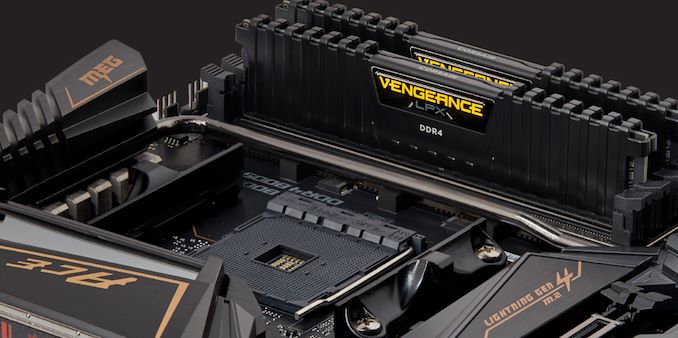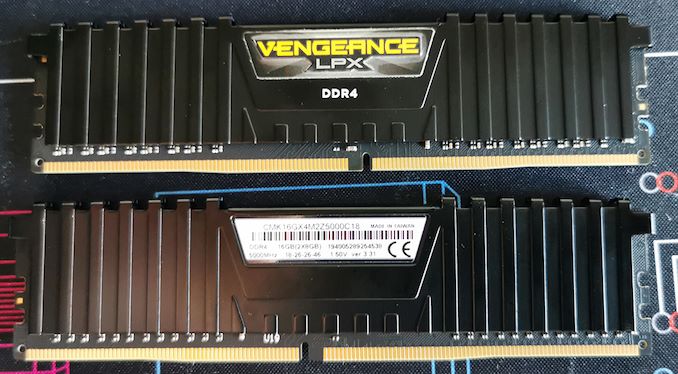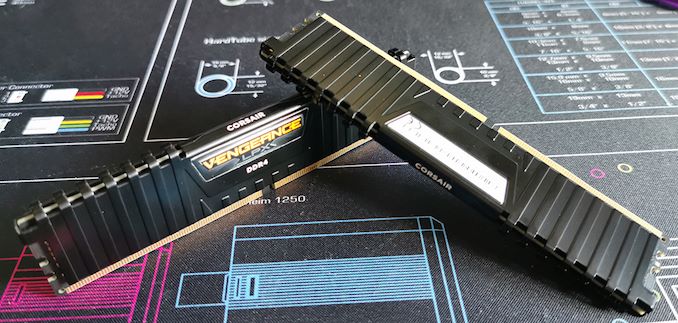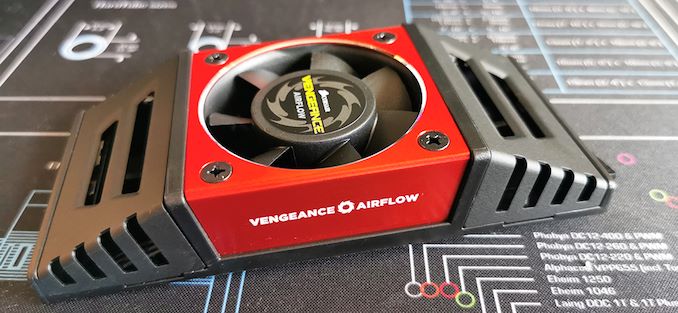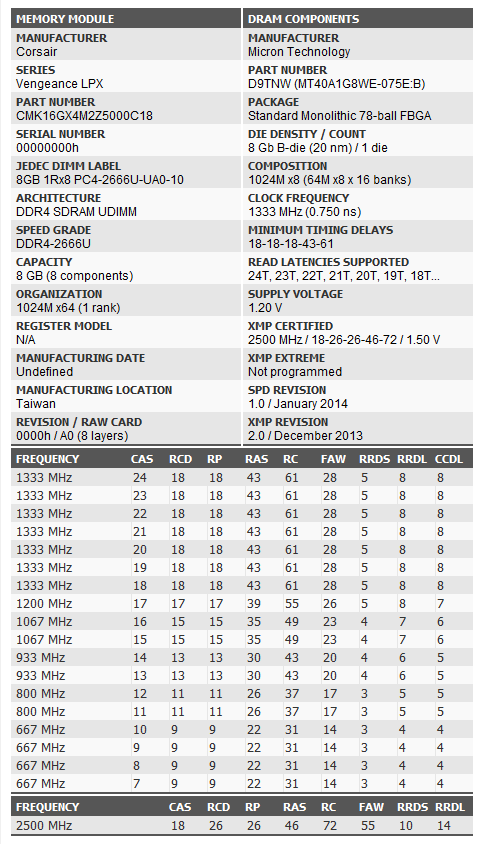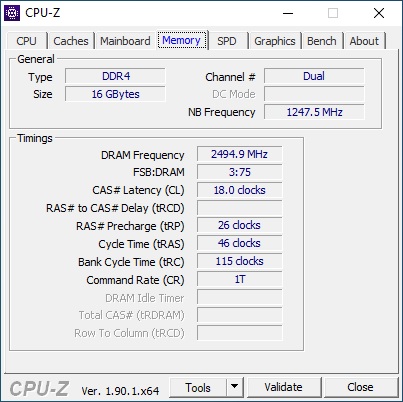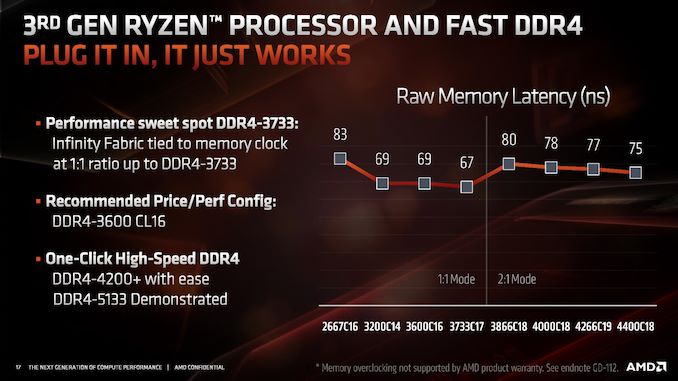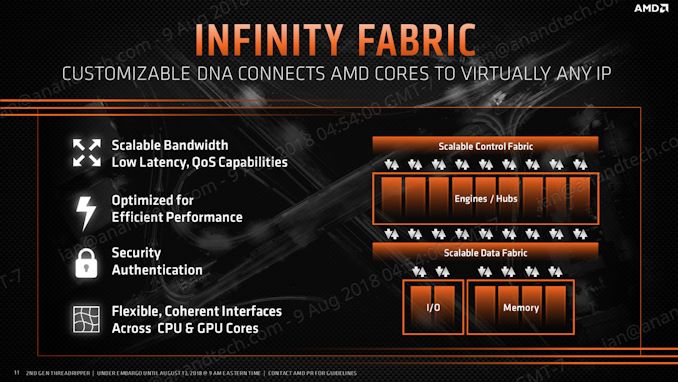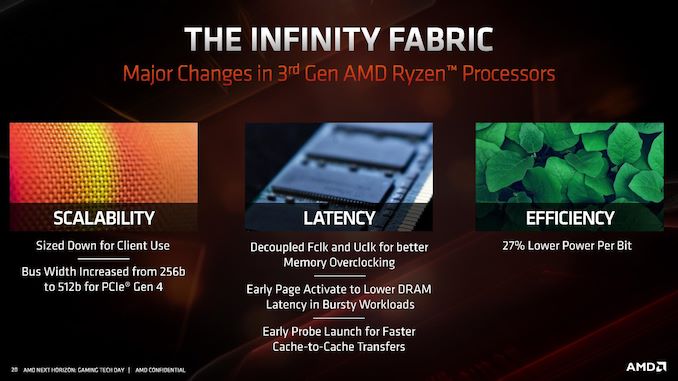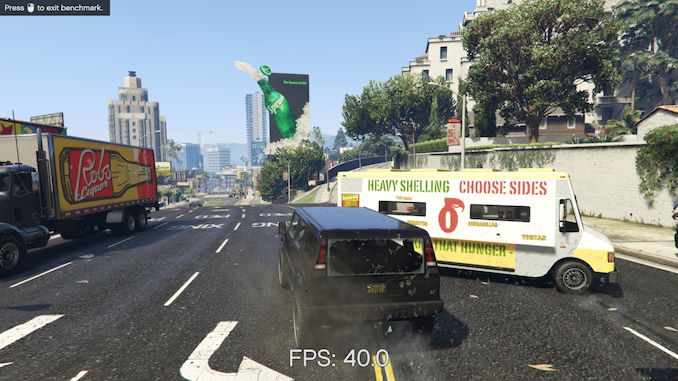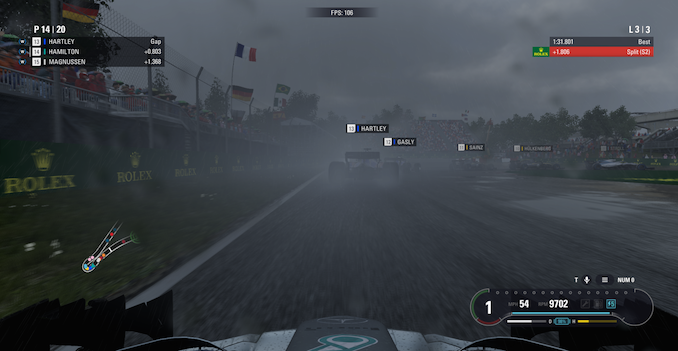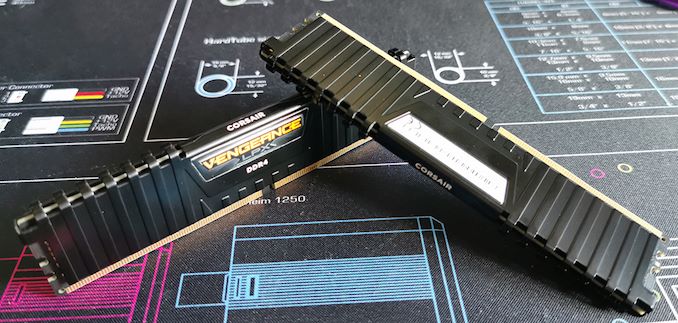
Original Link: https://www.anandtech.com/show/15089/the-corsair-ddr4-5000-vengeance-lpx-memory-review
The Corsair DDR4-5000 Vengeance LPX Review: Super-Binned, Super Exclusive
by Gavin Bonshor on January 27, 2020 9:00 AM EST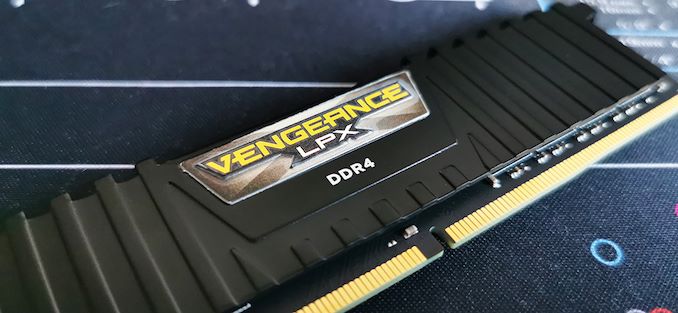
The consumer memory industry has been teasing DDR4-5000 for a few months now. We saw one company show some DDR4-5000 modules at Computex back in July 2019, running on an MSI MPG Z390I GAMING EDGE AC with an Intel Core i7-8086K processor, but the company said at the time that it didn’t make sense to release them because (at the time) only 2% of top-end CPUs could actually keep up with such a high memory speed. Fast forward to November a few key things have changed.
Micron’s new 8 Gbit Revision-E DDR4 chips (Rev.E or “Micron E-die”) first gained attention in April, and now they’ve matured through rigorous testing and qualification for the high-end memory kits. Enter the Corsair Vengeance LPX DDR4-5000 memory kits, which have been QVL'ed for use with MSI's high-end X570 models to give users blazing-fast memory for Ryzen 3000 processors.
Corsair DDR4-5000 Vengeance LPX Overview
AMD’s new Ryzen 3000 processors hit the market with a new memory controller capable of running extremely high speeds. It also helps that the CPU can now enable memory and Infinity Fabric ratios, which allow the fast memory to take advantage of the memory controller. Taking all of this into account, Corsair is now confident enough to be the first DRAM retailer to bring DDR4-5000 to market.
Behind the unassuming CMK16GX4M2Z5000C18 part number is a kit made with Micron 8 Gbit Revision E chips. Each of the chips have been individually tested for overclocking headroom, and are used with Corsair’s custom 8-layer PCB and cooled with anodized aluminium heat spreaders. Corsair has stuck with the low-profile, non-RGB Vengeance LPX design and included its Vengeance Airflow fan to maximise cooling, but also to provide that unassuming look.
Visual Inspection
The Corsair Vengeance LPX DDR4-5000 memory kit is designed for high-end Ryzen 3000 processors equipped on X570 motherboards. At present, only specific MSI motherboard models, including the MEG X570 Godlike, the MEG X570 Ace, and the MEG X570 Unify have been officially validated (or 'QVL'ed') to work with this kit.
QVL stands for Qualified Vendor List. If a product is on this list, it means that the manufacturer has done testing to say that these two products should work together without issues. Anything not on list doesn't mean it won't work, but it hasn't been validated.
The DDR4-5000 memory comes with a single XMP 2.0 profile which is rated for 5000 MT/s, with latency timings of 18-26-26-46 and has an operating voltage of 1.50 V. The Corsair Vengeance LPX DDR4-5000 kit is formed by two 8 GB memory sticks. Corsair's Vengeance LPX heatsinks are technically low profile with a height of just 31 mm. This is great for cooler compatibility as these memory sticks will fit under most CPU air tower coolers.
The stylings are consistent with the rest of its Vengeance LPX range, with anodised aluminium low profile heatsinks. Opting for a less aggressive heatsink design allows for better compatibility with larger air coolers. The black LPX heatsinks are 31 mm tall which should allow these to fit in with any system, and the black aluminium anodizing looks subtle enough to fit into most system configurations in terms of style. The Corsair Vengeance LPX range doesn't use integrated RGB LEDs and instead opts for a more clean-cut approach to its design.
Although Corsair's Vengeance LPX series is usually available in white, black, blue and red colors, the DDR4-5000 kit is only available in black, at present. Bundled with the Corsair Vengeance LPX DDR4-5000 kit is a red and black four-slot memory cooler. The cooler itself includes a 3-pin fan connector which will work in both 3-pin and 4-pin fan headers.
The Corsair Vengeance LPX DDR4-5000 kit is specifically using Micron ICs which they say are cherry-picked for maximum performance. This means Corsair is stating that it is essentially binning its memory ICs to guarantee they can deliver the 5000 MT/s speeds it advertises. With our probing above, it lists the kit using Micron B-Die, which would be somewhat spectacular. We confirmed with Corsair that these are E-die. Interestingly Corsair is using its 8-layer PCB design which is impressive and is likely a reason why it is capable of reaching DDR4-5000 in a low profile kit.
How To Test DDR4-5000 Memory
Over the next page, we go into some detail about the effect high speed memory has on Ryzen 3000 processors, but it's important to note that fast memory has had a checkered past.
Back in the days of DDR3, when systems would run DDR3-1333 as the rated memory, we saw plenty of potential uplift in performance moving to DDR3-1866, DDR3-2133, because at a fundamental level DDR3-1333 was horrifically slow. For anything compute limited, there was little difference, but for anything that touched the memory, it was heavily advised to get the fast memory. The biggest impact with fast memory was always integrated graphics, where memory bandwidth is always king.
Memory Scaling on Haswell CPU, IGP and dGPU: DDR3-1333 to DDR3-3000
For DDR4, we have seen a similar effect, but it has been relatively muted. Original DDR4 systems were released with DDR4-2133 support, but over time the latest hardware now supports DDR4-2666, DDR4-2933, or DDR4-3200 as standard.
Zen and Vega DDR4 Memory Scaling on AMD's APUs
AMD has been at the forefront of this, with the ability to rate their memory controllers at very fast standards. This means that a jump from DDR4-3200 to DDR4-3600, through buying fast memory, isn't as much of a jump as 400 MT/s used to be.
For Ryzen 3000, the effect is compounded. AMD showcased its memory suggestions when the product was launched, showing that DDR4-3600 is a sweet spot, because the memory frequency and infinity fabric frequency, which manages data inside the processor, were synchronized. Going above DDR4-3600 (or to DDR4-3733) would cause the infinity fabric to be derated by half, effectively making it 1800 MT/s. There were still benefits to this, although they would require super-fast memory in order to realise them. We'll cover more detail about the infinity fabric on the next page.
With DDR4-5000, the de-rated infinity fabric runs at 2500 MT/s, which is a lot nearer to the default running speed than most. Of course, there are still benefits running the DRAM this fast, so those are not discounted. The downside, however, is that traditionally the best recipient of fast memory has been integrated graphics. The Ryzen 3000 desktop CPUs built on Zen 2 do not have any model with integrated graphics. Not only that, but users with integrated graphics are unlikely to spend buckets of money on super-fast memory. It makes testing it in real-world a little tricky.
For our part, we subjected the memory to a range of our workstation tests, where memory can be important. We decided to test this memory in three ways: AMD's supported maximum (DDR4-3200), as near as to AMD's recommended overclock (DDR4-3600) as is comfortable on almost every CPU, and the speed of this kit (DDR4-5000), all at the same latencies as the XMP profile of the kit (C18). As with other memory reviews, there are going to be a number of benchmarks which show no difference, however as much as this memory kit is going to be rare, the effects of the high speed are in-of themselves niche. The following pages of benchmarks will show this.
Infinity Fabric Overclocking: What the FCLK
With AMD’s 3rd generation Ryzen processors, AMD has increased the flexibility of the memory subsystem and added separate control for two elements dubbed FCLK and UCLK. These elements have technically always been present, but previously were always linked to memory speed. Before we proceed though, some definitions:
FCLK – Fabric ClocK. FCLK controls the speed of AMD’s Infinity Fabric, which handles communication across their CPUs. On 3rd generation Ryzen, Infinity Fabric and therefore FCLK or Fabric Clock has particular responsibility for the connections between the Core dies and the IO die. UCLK – Unified memory controller ClocK.
UCLK - This controls the speed of the memory controller itself.
MEMCLK – Memory clock on DDR4 memory is often referred to by the data rate, for example, this “5000 MT/s” kit is so called because at the advertised speed data is transferred 5000 million times per second. The physical clock signal that governs this data transfer, however, is 2500 MHz at the advertised speed – the data rate is double the physical clock, hence Double Data Rate. In AMD’s language this physical clock is called MEMCLK, and often shows up in bios settings under this name. MEMCLK is important because of how FCLK and UCLK relate to it.
Technically, all of these elements have always existed on all AMD’s Zen-based processors, back to 1st generation Ryzen and the enterprise equivalents, but FCLK and UCLK were always locked to MEMCLK making them effectively one and the same. What differs with 3rd generation Ryzen is that rather than being tied to MEMCLK, FCLK can now be set totally independently and UCLK has a choice of two ratios to MEMCLK – 1:1 and 1:2 (UCLK:MEMCLK).
Setting FCLK on Matisse
Although FCLK is now free to run at any speed, in practice there’s a performance bonus from running FCLK, UCLK and MEMCLK synchronized together. At lower MEMCLK speeds this may be outweighed by increasing – more specifically, overclocking – FCLK independently and when overclocking to very high MEMCLK it is simply no longer possible for FCLK to keep up and it must be run at a reduced speed.
By default FCLK, UCLK and MEMCLK are still synced together on 3rd generation Ryzen for speeds up to and including DDR4-3600 (1800 MHz FCLK/UCLK/MEMCLK), and as a result users with DDR4-3600 kits find these parameters well optimised without additional tweaking.
With this extremely high-speed DDR4-5000 kit, FCLK and UCLK cannot be synched with MEMCLK, and for the best possible performance, it’s advisable to manually overclock FCLK independently. On MSI motherboards as tested, the FCLK frequency and UCLK ratio (“UCLK DIV1 MODE”) are found in the “DRAM Setting” portion of the OC menu.
Test Bed
To test the performance of the Corsair Vengeance LPX DDR4-5000 memory kit, we tested the kit at three different frequencies with Infinity Fabric clocks in a ration of 2:1. Our maximum limit on the Infinity Fabric before we reached instability was 1800 MHz, which is a common limit for users. Some Ryzen 3000 processors can clock as high as 1900 MHz which would equal DDR4-3800, but AMD themselves say the sweet spot for memory performance on Ryzen 3000 and X570 is around DDR4-3600.
| Test Setup | |||
| Processor | AMD Ryzen 3700X, 65W, $329 8 Cores, 16 Threads, 3.6 GHz (4.4 GHz Turbo) |
||
| Motherboard | MSI MEG X570 Ace (BIOS 1.40 - ABBA) | ||
| Cooling | ID-Cooling Auraflow Pink 240mm AIO | ||
| Power Supply | Thermaltake Toughpower Grand 1200W Gold PSU | ||
| Memory | 2x8GB Corsair Vengeance Tested at: DDR4-3200 18-26-26-46 1T (FCLK 1600 MHz) DDR4-3600 18-26-26-46 1T (FCLK 1800 MHz) DDR4-5000 18-26-26-46 1T (FCLK 1800 MHz) |
||
| Video Card | ASRock RX 5700 XT Taichi X 8G OC+ (1810/2025 Boost) | ||
| Hard Drive | Crucial MX300 1TB | ||
| Case | Open Benchtable BC1.1 (Silver) | ||
| Operating System | Windows 10 1903 inc. Spectre/Meltdown Patches | ||
CPU Performance, Short Form
For our motherboard reviews, we use our short form testing method. These tests usually focus on if a motherboard is using MultiCore Turbo (the feature used to have maximum turbo on at all times, giving a frequency advantage), or if there are slight gains to be had from tweaking the firmware. We put the memory settings at the CPU manufacturers suggested frequency, making it very easy to see which motherboards have MCT enabled by default.
WinRAR 5.60b3: Archiving Tool
My compression tool of choice is often WinRAR, having been one of the first tools a number of my generation used over two decades ago. The interface has not changed much, although the integration with Windows right click commands is always a plus. It has no in-built test, so we run a compression over a set directory containing over thirty 60-second video files and 2000 small web-based files at a normal compression rate.
WinRAR is variable threaded but also susceptible to caching, so in our test we run it 10 times and take the average of the last five, leaving the test purely for raw CPU compute performance.
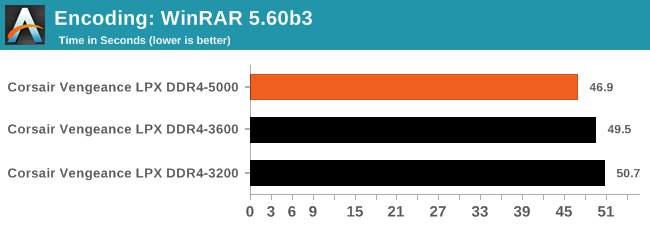
WinRAR is often memory bound when there are plenty of cores, and we see that here. The jump from 3200 to 3600 is only 1.2 seconds for 400 MT/s, but up to DDR4-5000 gives in total a 3.8 second boost for +1800 MT/s, which is almost a linear scaling improvement.
DigiCortex 1.20: Sea Slug Brain Simulation
This benchmark was originally designed for simulation and visualization of neuron and synapse activity, as is commonly found in the brain. The software comes with a variety of benchmark modes, and we take the small benchmark which runs a 32k neuron / 1.8B synapse simulation, equivalent to a Sea Slug.

Example of a 2.1B neuron simulation
We report the results as the ability to simulate the data as a fraction of real-time, so anything above a ‘one’ is suitable for real-time work. Out of the two modes, a ‘non-firing’ mode which is DRAM heavy and a ‘firing’ mode which has CPU work, we choose the latter. Despite this, the benchmark is still affected by DRAM speed a fair amount.
DigiCortex can be downloaded from http://www.digicortex.net/
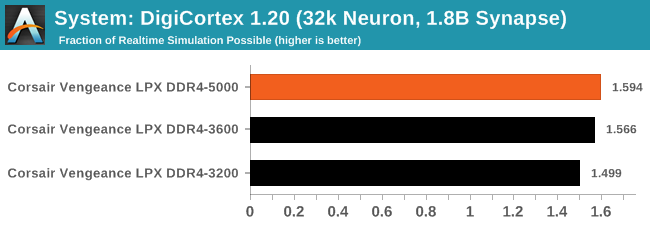
Similarly with DigiCortex, there are gains to be had by increasing the memory frequency. Most of the gain here happens between 3200 and 3600 though, with only a small jump going further to DDR4-5000.
Handbrake 1.1.0: Streaming and Archival Video Transcoding
A popular open source tool, Handbrake is the anything-to-anything video conversion software that a number of people use as a reference point. The danger is always on version numbers and optimization, for example the latest versions of the software can take advantage of AVX-512 and OpenCL to accelerate certain types of transcoding and algorithms. The version we use here is a pure CPU play, with common transcoding variations.
We have split Handbrake up into several tests, using a Logitech C920 1080p60 native webcam recording (essentially a streamer recording), and convert them into two types of streaming formats and one for archival. The output settings used are:
- 720p60 at 6000 kbps constant bit rate, fast setting, high profile
- 1080p60 at 3500 kbps constant bit rate, faster setting, main profile
- 1080p60 HEVC at 3500 kbps variable bit rate, fast setting, main profile
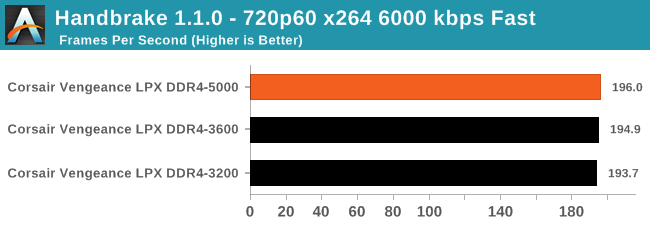
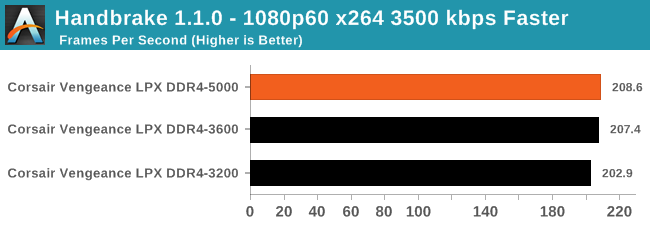
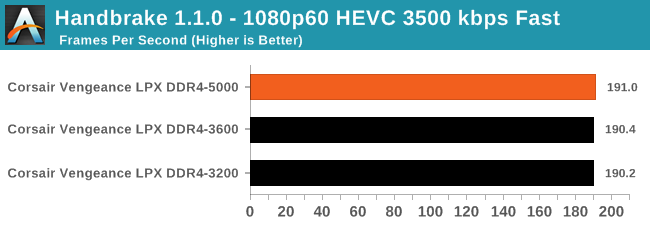
All three of our video transcoding tests saw small minor gains, although not substantial enough to justify the cost of the kit.
Blender 2.79b: 3D Creation Suite
A high profile rendering tool, Blender is open-source allowing for massive amounts of configurability, and is used by a number of high-profile animation studios worldwide. The organization recently released a Blender benchmark package, a couple of weeks after we had narrowed our Blender test for our new suite, however their test can take over an hour. For our results, we run one of the sub-tests in that suite through the command line - a standard ‘bmw27’ scene in CPU only mode, and measure the time to complete the render.
Blender can be downloaded at https://www.blender.org/download/
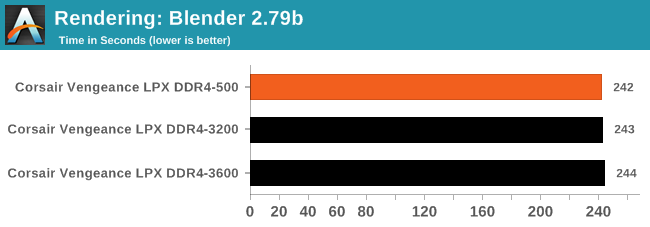
Blender's differences are within the margin of error.
POV-Ray 3.7.1: Ray Tracing
The Persistence of Vision ray tracing engine is another well-known benchmarking tool, which was in a state of relative hibernation until AMD released its Zen processors, to which suddenly both Intel and AMD were submitting code to the main branch of the open source project. For our test, we use the built-in benchmark for all-cores, called from the command line.
POV-Ray can be downloaded from http://www.povray.org/
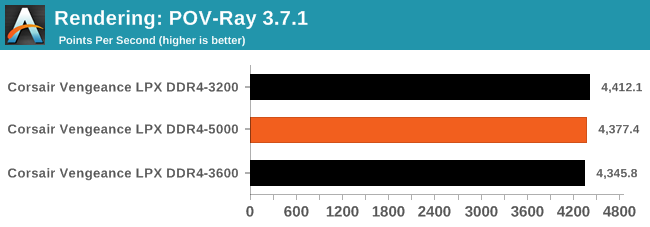
POV-Ray is also within the margin of error.
7-zip v1805: Popular Open-Source Encoding Engine
Out of our compression/decompression tool tests, 7-zip is the most requested and comes with a built-in benchmark. For our test suite, we’ve pulled the latest version of the software and we run the benchmark from the command line, reporting the compression, decompression, and a combined score.
It is noted in this benchmark that the latest multi-die processors have very bi-modal performance between compression and decompression, performing well in one and badly in the other. There are also discussions around how the Windows Scheduler is implementing every thread. As we get more results, it will be interesting to see how this plays out.
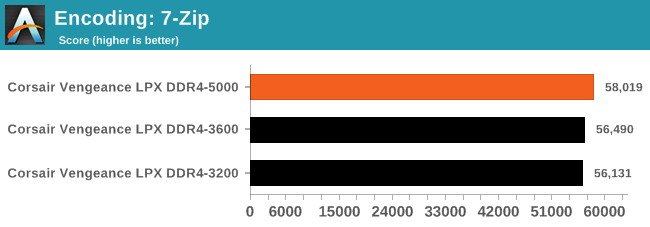
7zip's benchmark is one that shows a sizeable bump going up to DDR4-5000.
3D Particle Movement v2.1: Brownian Motion
Our 3DPM test is a custom built benchmark designed to simulate six different particle movement algorithms of points in a 3D space. The algorithms were developed as part of my PhD., and while ultimately perform best on a GPU, provide a good idea on how instruction streams are interpreted by different microarchitectures.
A key part of the algorithms is the random number generation – we use relatively fast generation which ends up implementing dependency chains in the code. The upgrade over the naïve first version of this code solved for false sharing in the caches, a major bottleneck. We are also looking at AVX2 and AVX512 versions of this benchmark for future reviews.
For this test, we run a stock particle set over the six algorithms for 20 seconds apiece, with 10 second pauses, and report the total rate of particle movement, in millions of operations (movements) per second. We use a non-AVX version here.
3DPM v2.1 can be downloaded from our server: 3DPMv2.1.rar (13.0 MB)
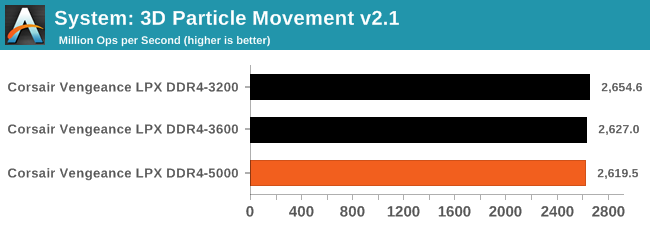
As per usual, our 3DPM test seems to favor slow memory. We saw this in other reviews of high speed memory, although this time with high speed DDR4 on AMD, the difference isn't too much and can be considered within the margin of error.
Gaming Performance
Civilization 6 (DX12)
Originally penned by Sid Meier and his team, the Civ series of turn-based strategy games are a cult classic, and many an excuse for an all-nighter trying to get Gandhi to declare war on you due to an integer overflow. Truth be told I never actually played the first version, but every edition from the second to the sixth, including the fourth as voiced by the late Leonard Nimoy, it a game that is easy to pick up, but hard to master.

Benchmarking Civilization has always been somewhat of an oxymoron – for a turn based strategy game, the frame rate is not necessarily the important thing here and even in the right mood, something as low as 5 frames per second can be enough. With Civilization 6 however, Firaxis went hardcore on visual fidelity, trying to pull you into the game. As a result, Civilization can taxing on graphics and CPUs as we crank up the details, especially in DirectX 12.
Perhaps a more poignant benchmark would be during the late game, when in the older versions of Civilization it could take 20 minutes to cycle around the AI players before the human regained control. The new version of Civilization has an integrated ‘AI Benchmark’, although it is not currently part of our benchmark portfolio yet, due to technical reasons which we are trying to solve. Instead, we run the graphics test, which provides an example of a mid-game setup at our settings.
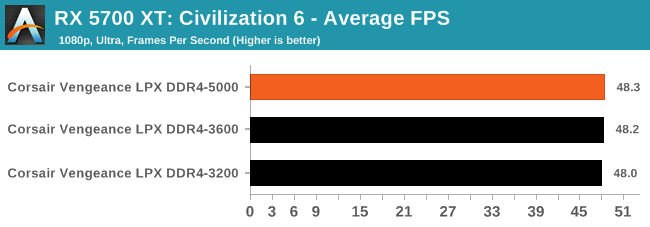
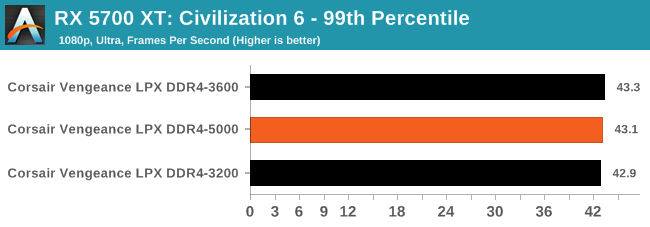
Grand Theft Auto V
The highly anticipated iteration of the Grand Theft Auto franchise hit the shelves on April 14th 2015, with both AMD and NVIDIA in tow to help optimize the title. GTA doesn’t provide graphical presets, but opens up the options to users and extends the boundaries by pushing even the hardest systems to the limit using Rockstar’s Advanced Game Engine under DirectX 11. Whether the user is flying high in the mountains with long draw distances or dealing with assorted trash in the city, when cranked up to maximum it creates stunning visuals but hard work for both the CPU and the GPU.
For our test we have scripted a version of the in-game benchmark. The in-game benchmark consists of five scenarios: four short panning shots with varying lighting and weather effects, and a fifth action sequence that lasts around 90 seconds. We use only the final part of the benchmark, which combines a flight scene in a jet followed by an inner city drive-by through several intersections followed by ramming a tanker that explodes, causing other cars to explode as well. This is a mix of distance rendering followed by a detailed near-rendering action sequence, and the title thankfully spits out frame time data.
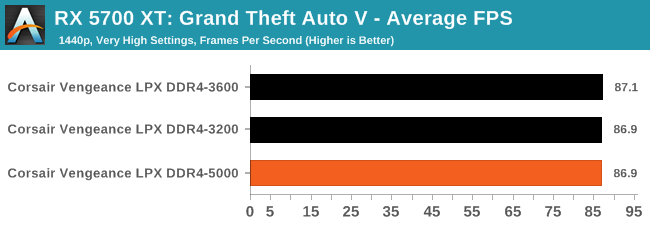
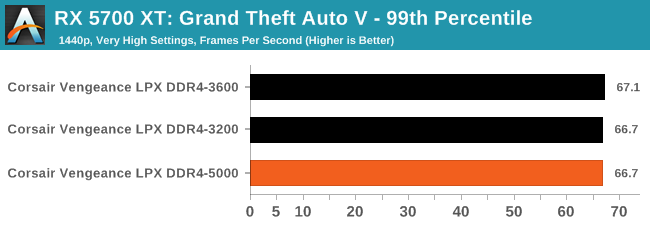
F1 2018
Aside from keeping up-to-date on the Formula One world, F1 2017 added HDR support, which F1 2018 has maintained; otherwise, we should see any newer versions of Codemasters' EGO engine find its way into F1. Graphically demanding in its own right, F1 2018 keeps a useful racing-type graphics workload in our benchmarks.
Aside from keeping up-to-date on the Formula One world, F1 2017 added HDR support, which F1 2018 has maintained. We use the in-game benchmark, set to run on the Montreal track in the wet, driving as Lewis Hamilton from last place on the grid. Data is taken over a one-lap race.
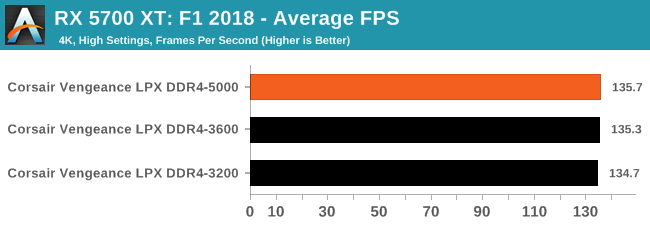
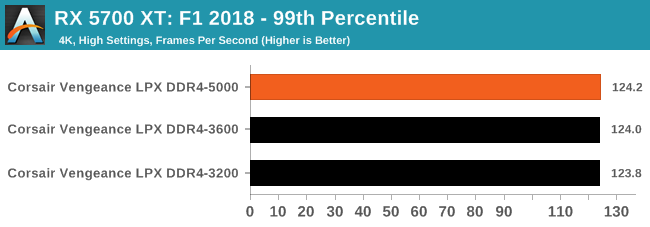
For our discrete gaming tests, we saw very little difference between all three speed settings. This is because at the end of the day, the resolutions that people who buy this kit are likely to play at aren't going to be memory bound - it's almost always GPU bound. What we really need is an APU here to see some differences.
Corsair DDR4-5000 Vengeance LPX
When evaluating a memory kit that costs $1200, there’s one very obvious question: who is this for? Is it for gamers? Content creators? It’s certainly not for the price-conscious. There are some people with a practically unlimited amount of money who are willing to pay it for the very best, perhaps Corsair are doing it for them? Or perhaps it's just because Corsair can do it?
In our testing, we saw minimal gains in our compute-heavy tasks and in gaming when compared to DDR4-3200 and DDR4-3600. This is primarily down to the Infinity Fabric blockage which on our Ryzen 7 3700X, is around 1800 MHz. After this mark, it limits memory performance above DDR4-3600 (2:1 ratio on the FLCK). While we did see the benefit in our WinRAR and 7-Zip benchmarks which tend to scale well with memory, it comes down to the price. Is the extra $700 worth the 2.6 seconds saving in WinRAR from this DDR4-5000 kit from a DDR4-3600 kit? Performance in gaming between the speeds was inconsequential.
As for our experiences, the XMP for this kit includes only one profile – the advertised DDR4-5000. It’s much better to include this than require users to enter timings manually, but it’s not ideal that this is the only profile included. Other kits with a less extreme advertised speed sometimes include a second, lower XMP profile for the benefit of those whose CPU doesn’t have a strong enough memory controller to overclock to the full rated speed, and with DDR4-5000 being so hard to run we would have much preferred to see the same here. Users can of course just lower the memory ratio to run at a slower speed, but by providing a second XMP profile Corsair could have offered better-optimized latency timings at lower speeds.
To Validate or not to Validate
When it comes to extreme memory speeds, you don’t just need a high-quality motherboard capable of those speeds – you also need to make sure the board and memory are specifically qualified to work together. Unfortunately, unlike other memory vendors Corsair don’t publish a list of qualified motherboards, the kit is just listed as being for “X570”, but they have told us the modules were developed and validated on MSI’s X570 Godlike, MEG X570 Ace, MEG X570 Unify and Prestige X570 Creation. Motherboard vendors produce their own lists of qualified memory modules which you can check, and MSI’s website confirms that these modules are validated with their four top-end X570 boards.
SPD (Serial Presence Detect) refers both to a small physical EEPROM chip on a memory module, and the information stored on that chip. SPD information is used to signal what the capability of the memory is when a system boots, in order to configure the memory for fast and stable operation at stock speeds. The SPD can also optionally include extensions that store profiles for easy memory overclock, and on DDR4 Intel XMP has become a de facto standard with even modules designed specifically for AMD platforms relying on the Intel XMP specification to store overclock profiles. It should be stressed that although modules are rated to run at their XMP speed, it is still an overclock of the memory controller that isn’t guaranteed to run.
As far as stock operation, Corsair has rated these modules for DDR4-2666. This is disappointing in a modern enthusiast kit as the processors the kit is designed for support up to DDR4-3200 at stock speeds. A user who doesn’t take the time to configure an XMP overclock isn’t just going to find these modules slower than expected but will find them slower than far cheaper kits that are rated for DDR4-3200 at stock.
Without the option of a second XMP 2.0 profile to play with, it came down to the silicon gods whether or not we could boot at DDR4-5000 or not. Corsair told us that they had had the best luck with Ryzen 7 3700X CPUs. With our CPU, not once during testing could we just enable the XMP 2.0 on our MSI MEG X570 Ace and POST into Windows without copious amounts of errors. This is disappointing for a $1000+ kit of memory. To get the kit 100% stable, we needed to pump more than ideal levels of voltage through the processors SoC, up to 1.3 V was needed. We also check this kit on the ASRock X570 Aqua and ASUS ROG Crosshair VIII Impact to see if it would work despite not making the QVL list, and the kit did work, but we still required lots of SoC voltage for POST and stability.
It's clear that the Corsair Vengeance LPX DDR4-5000 isn't for every Ryzen 3000 processor. A user needs to determine if their CPU has a strong enough memory controller, or given that the user is spending $1200+ on memory, perhaps buying a couple of CPUs might be required, and then either sell/buy new others until a decent memory controller is found. In the case of our Ryzen 7 3700X testbed CPU, it was hit and miss. Yes, we did achieve DDR4-5000 with vast amounts of tweaks of settings and voltages in the firmware for our testing, but for the novice system builder, it's going to be playing a game of pot luck which for the price point.
Conclusion
The question may be, is this literally the fastest memory you can get? At retail, absolutely. In terms of raw MHz, it is. Practically speaking though, unless you’re already getting the absolute best in every other part of your system there’s no reason to spend such a huge amount on memory.
Corsair told us in their testing that actually the lower end Ryzen 3000 processors may have more success with memory stability, due to only having one chiplet, which puts less stress on the internal fabric. Higher core chips with two chiplets may have more issues due to overall heat and stress. It also comes down to the integrated memory controller on the chips: some are strong, some are weak, and it's a silicon lottery. There might be a day where memory vendors have to sell pre-binned CPUs with their high-end memory in order to ensure peak performance.
With this kit, Corsair is sending a clear message. The company wants us to know that their custom 8-layer PCB internal screening process and anodised aluminium heat spreaders are capable of producing memory that hits the highest speeds on the market. This is a team effort helped by AMD’s processors and MSI’s motherboards, but it’s undeniably very impressive. It's just a shame that AMD doesn't have a big APU to pair with it, as that's where I think we would see the biggest improvement in performance.

